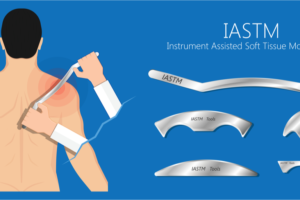The Top 7 Things You Need to Know About Graston Technique
 If you visit the chiropractor, the main tool they will use for spinal adjustments are their hands. However, occasionally you will see them use instruments designed to help make your treatment more effective. One of these tools is a part of the Graston Technique, a form of soft tissue mobilization that assists with patient outcomes for a range of concerns. When combined with therapeutic exercise and a comprehensive plan of care, the Graston Technique can help patients return to pain-free movement and function. Keep reading to learn more about this technique and how it can help you.
If you visit the chiropractor, the main tool they will use for spinal adjustments are their hands. However, occasionally you will see them use instruments designed to help make your treatment more effective. One of these tools is a part of the Graston Technique, a form of soft tissue mobilization that assists with patient outcomes for a range of concerns. When combined with therapeutic exercise and a comprehensive plan of care, the Graston Technique can help patients return to pain-free movement and function. Keep reading to learn more about this technique and how it can help you.
1. It’s Evidence-Based
There are a wealth of studies related to the Graston Technique and its effectiveness. Through this intense research, it has been found to be effective as much as 75% to 90% of the time in a range of conditions. This evidence has shown that the Graston Technique:
- Separates and breaks down collagen cross-links, splaying and stretching connective tissue and muscle fibers
- Facilitates reflex changes in chronic muscle holding pattern
- Alters/inhibits spinal reflex activity
- Increases the rate and amount of blood flow to the impacted area
- Increases cellular activity in the region
- Increases histamine response secondary to mast cell activity
2. It Uses a Unique Set of Instruments
There are six core tools used in the Graston Technique, each made of stainless steel in both concave and convex shapes. The edges of the tools are rounded rather than sharp, as they are used to scan over the body and detect areas of injured fibrotic tissue. This both identifies problems as well as treating them.
Graston Technique instruments can only be sold to licensed professionals who are trained in using them.
3. It Requires Extensive Training
One reason that not everyone can buy the tools for the Graston Technique is that it requires training to be able to perform properly. There are two modules required to get this licensure.
Module 1 is a 12-hour course focusing on the way to use the instruments, as well as research into the technique, indications, and contraindications. There is also hands-on practice with the instruments.
Module 2 is a 14-hour course that is specific to specific conditions and how to apply the technique in these cases.
4. It’s About Scar Tissue
When any injury impacts soft tissue, the body tends to repair that tissue in a haphazard way with new patterns that lead to scar tissue. Scar tissue is not painful, but it can limit the range of motion, cause pain, and lead to further problems if you are re-injured.
Scar tissue can also negatively impact sensory-motor firing rates and frequencies, which perpetuates a dysfunctional cycle of nervous system sensitization, pain, and dysfunctional movement and motor output. The Graston Technique breaks this cycle by addressing scar tissue.
5. It’s Beneficial for Almost Everyone
If you present with pain that can be addressed by the Graston Technique, you will be able to benefit from treatment. Common conditions treated include muscle sprain and strain, Achilles tendinosis, Carpal tunnel syndrome, plantar fasciitis, shin splints, and tennis elbow.
Certain conditions may preclude you from undergoing this treatment right away. Open wounds in the area, cancer, pregnancy, fractures, or being on blood thinners are all contraindications. Your doctor will be able to tell you if you are eligible for care.
6. It’s Called a Massage
The actual treatment performed with the Graston Technique instruments is known as the Graston Technique massage, though it may not feel like a traditional massage. A cross-friction motion is used that may involve brushing or rubbing against the grain of your scar tissue. This actually introduces minor trauma to the area, causing inflammation and forcing the area to begin healing itself.
Treatment is focused on the kinetic chain, so a patient who is seeking treatment for back pain may actually receive this massage along the hip flexors, abdomen, hamstrings, shoulders, and other regions of the body that are connected through fascial tissue.
7. It’s Part of a Comprehensive Plan
While it is extremely effective, the Graston Technique is rarely used on its own. Instead, it is usually a part of a personalized treatment plan that includes physical therapy, chiropractic care, and other necessary practices. After your session, you will likely be given exercises and stretches to do at home as part of a strengthening program that helps you heal.
